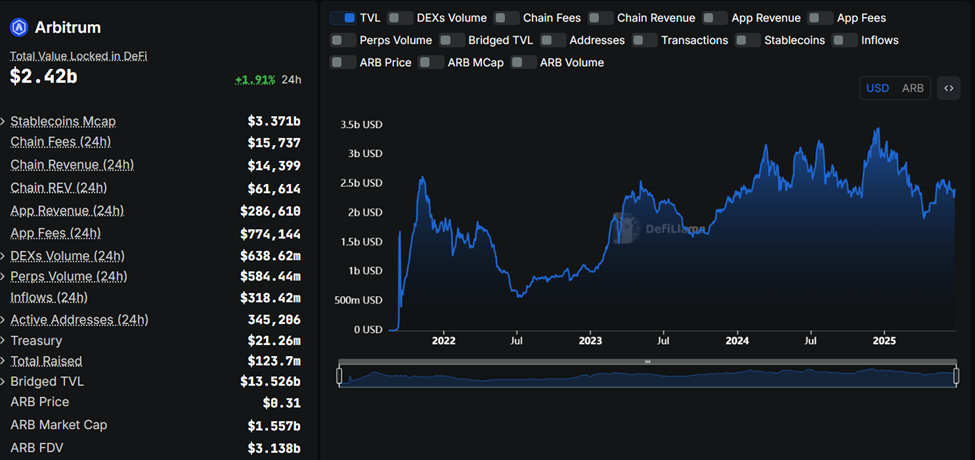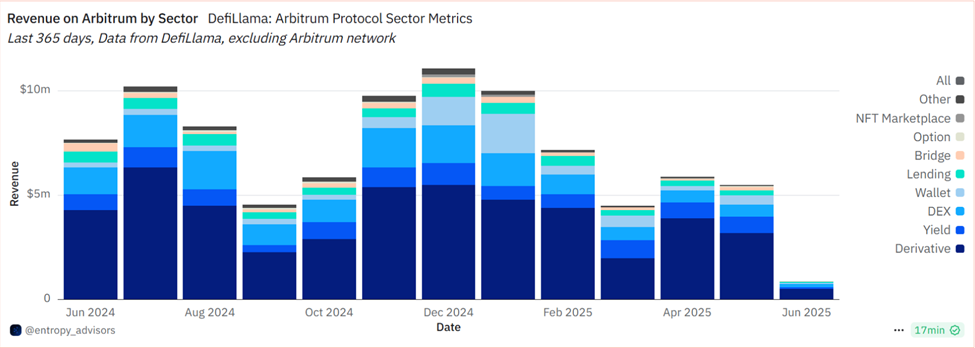-
Arbitrum’s Layer-2 network experiences a significant 23% revenue increase to $1.43 million, fueled by real-world asset (RWA) integrations and decentralized exchanges (DEXs).
-
Tokenized RWAs on Arbitrum have reached a record $300 million, with forecasts suggesting a rise to $1 billion by year-end, underscoring growing institutional adoption of on-chain assets.
-
Emerging protocols like Ostium and Penpie are intensifying competition and innovation, positioning Arbitrum as a leading contender in the Layer-2 ecosystem.
Arbitrum’s revenue jumps 23% driven by tokenized real-world assets and innovative DeFi protocols, signaling strong growth and institutional interest in Layer-2 solutions.
Arbitrum’s Revenue Growth Driven by Real-World Asset Integration and DeFi Expansion
Recent data from Dune Analytics reveals that Arbitrum generated $1.43 million in protocol revenue last week, marking a notable 23% increase from the previous period. This surge highlights renewed user engagement and developer activity within the network, reinforcing Arbitrum’s stature among top Layer-2 solutions.

Arbitrum’s total value locked (TVL) currently stands at $2.42 billion, according to DefiLlama, with real-world assets playing a pivotal role in this growth trajectory.

Tokenized real-world assets on Arbitrum have reached an all-time high of $300 million, with projections estimating a rise to $1 billion by the end of 2025. This rapid expansion signals a maturing ecosystem extending beyond traditional DeFi applications.
Entropy Advisors attribute part of this growth to Spiko’s tokenized short-term Eurobills (EUTBL), which surged by nearly $30 million overnight. Currently, EUTBL represents $128 million, or 41.6% of all tokenized RWAs on Arbitrum.
As Entropy Advisors noted on social media:
“We just hit an ATH: $300M in real-world assets tokenized on @arbitrum! @Spiko_finance’s EUTBL jumped ~$30M overnight and now leads with $128M – 41.6% of all tokenized assets on Arbitrum.
RWA narrative is accelerating, with TVL up 30x since this time last year.”
This 30-fold year-over-year increase in RWA TVL underscores growing institutional appetite for on-chain, yield-bearing instruments, positioning Arbitrum as a key platform for bridging traditional finance and DeFi.
Market Volatility and DeFi Fragmentation Present Challenges to Arbitrum’s Momentum
Despite the recent revenue gains, Arbitrum’s protocol income remains susceptible to broader market fluctuations. In May 2025, total revenue from Arbitrum-based protocols declined by 6.54% month-over-month to $5.5 million.
Entropy Advisors’ sector analysis reveals that derivatives dominate revenue streams with $3.18 million, followed by yield protocols at $781,000, DEXs at $599,000, wallets at $421,000, and lending platforms at $251,000.

Within the derivatives segment, GMX remains the leading perpetual DEX, though competitors such as Gains Network and HMX are rapidly closing the gap. Notably, Ostium has emerged as a significant contender, recently surpassing Vertex in both volume and market share.

This intensifying competition among perpetual DEXs is fostering innovation and compelling smaller protocols to either differentiate their offerings or consider consolidation strategies.
The yield sector is also evolving, with Penpie attracting a majority of yield-focused users recently. Meanwhile, platforms like Beefy, Pendle, and Toros are vying for specialized strategies and integrations. In the DEX space, Uniswap (UNI) continues to lead in revenue generation, but Mayan is gaining ground in market share.
As DeFi narratives diversify—from RWAs to complex derivatives—Arbitrum’s capacity to support a broad spectrum of high-performing protocols solidifies its leadership in the competitive Layer-2 landscape.
Projects such as Spiko, Ostium, and Penpie exemplify this trend, suggesting that Arbitrum’s next phase of growth will be driven by tangible utility rather than speculative hype.
Conclusion
Arbitrum’s recent revenue surge, fueled by tokenized real-world assets and dynamic DeFi protocols, highlights its expanding role in the Layer-2 ecosystem. Despite challenges from market volatility and increasing competition, the network’s ability to attract institutional interest and foster innovation positions it well for sustained growth. Stakeholders should monitor developments in RWA adoption and protocol diversification as key indicators of Arbitrum’s evolving market dominance.
